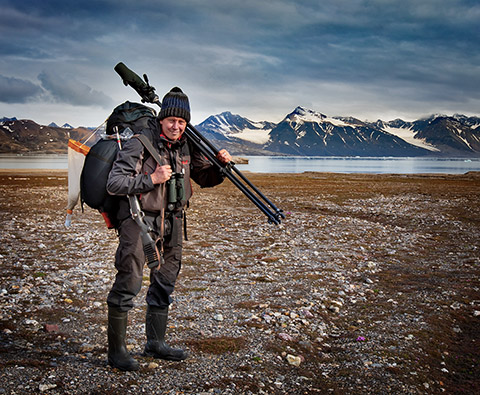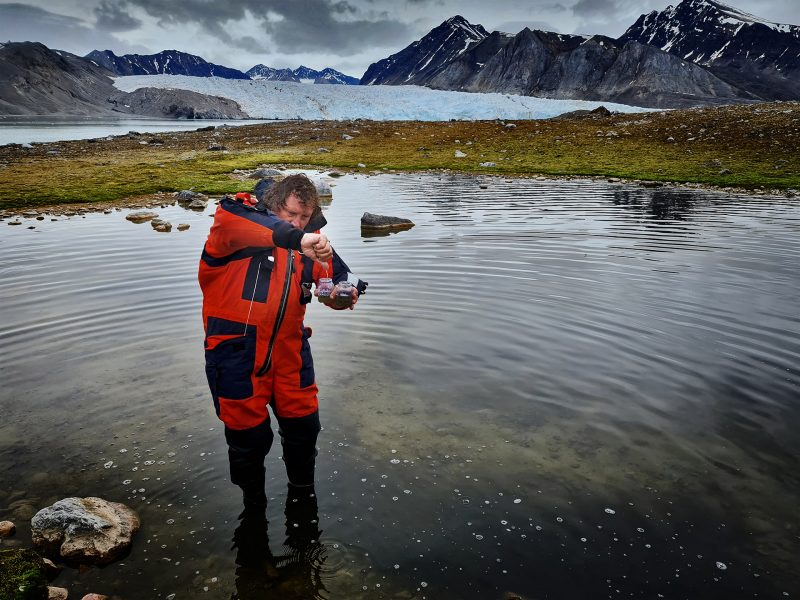
Climate change on the North Pole
It starts off small
Christophe Brochard couldn’t believe his eyes when he reached the little lakes where he’d been collecting water samples for several years now. The lakes are spread out over a fifteen-kilometre stretch Ny-Ålesund on Svalbard, the most northerly village in the world. Brochard had been walking for hours through the vast, silent landscape. When he finally reached his destination, his jaw dropped.
Nearly half the lakes had dried up. The lake beds were dry as a bone; the earth was cracked.
Cool
His initial response was a scientific one. The scientist in him thought: ‘Cool, now I can do a laboratory study!’ In a lab study, scientists control the circumstances of their experiment, allowing them to simulate extreme situations – such as as previously filled lakes drying up.
But then reality came and slapped him in the face.
‘You can see climate change happening in real time up here. I never thought any of these lakes could ever dry up. It’s dramatic’, says Brochard, visibly affected.
He returned to the island last summer to get more samples, concerned about what he would find there. To his relief, almost all the lakes were filled with meltwater from snow and ice.
At first I thought, cool, I can do a lab study
He still has to wait and see how last year’s extreme drought affected the flora and fauna in the lakes. He also doesn’t know what the future holds. After all, one wet summer in the Netherlands doesn’t mean that climate change isn’t that bad, and neither do low temperatures and increased snowfall on Svalbard.
Bitter cold
Brochard has been travelling to Svalbard for five years now. Braving the bitter cold, he studies algae – specifically desmids. He studies various types of these so-called bio-indicators that tell the ‘story of how a particular environment is doing’.
There are the psychrophilic kinds of algae, that prefer the cold and which are slowly disappearing because it’s getting too warm. And there are the thermophilic kinds, the newcomers, who don’t mind that it’s getting warmer. Finally, there are so-called super specialists; species that only exist in a single, specific location. In this case, Svalbard. Super specialists are very picky about the environment they live in. All these different types are interesting for study, because their arrival or departure signal changes in ecosystems. He knows, for example, that the difference of a single degree can have considerable effect on an ecosystem.
Brochard booked his first trip to Svalbard on the insistence of well-known polar researcher and UG colleague Maarten Loonen. He immediately fell in love. ‘The most remarkable about the place is the silence. And it’s so expansive: you can see all the way to the end of the fjord, and then it turns out that’s twenty kilometres away.’
Freshwater plankton
Loonen was so insistent because he felt Brochard could make an important contribution to research that was already taking place on Svalbard. Brochard specialises in phytoplankton and zooplankton. Freshwater plankton in polar areas hadn’t been studied very much yet, when they can provide so much information on, among others, the quality of the water.
If there are a lot of different kinds of plankton in the water, that’s a good sign; freshwater plankton is very sensitive to its environment. If plankton is missing from the water, however, that’s a bad sign, as plankton forms an important basis in the oceanic food chain. That means that if climate change leads to changes in the plankton population, that drastically affects all marine life.
It’s so awful, it makes me very emotional
Brochard hasn’t started analysing his water samples yet. That’s because analysing plankton isn’t as easy as, say, counting birds. The largest desmid, for example, is visible to the naked eye, but not very clearly. Analysing it takes time. ‘That’s why I use my microscope mainly for taking photos on Svalbard. I have the majority of my samples shipped back to the Netherlands so I can analyse them later.’
Obvious
The past few summers on Svalbard revolved around gaining knowledge and setting up the study. ‘I’ve now figured it out enough to start my analysis’, he says. ‘I’ll be starting at the end of 2021.’
There’s one conclusion he can draw without an extensive analysis, however. The effects of global warming are entirely obvious to him. The first year he visited the lakes, he measured a temperature of approximately nine degrees Celsius. The next year, one lake measures at sixteen degrees. Last summer, that lake had completely dried up. Of the approximately twenty lakes he visits every year, eight had dried up. That summer, a record temperature of twenty degrees was measured at Svalbard, much higher than its average summer temperature of six degrees Celsius.
‘Climate change is just so awful. It makes me very emotional’, the polar researcher says. After last year’s terrible find, Brochard was worried about what he’d encounter on the island this year.
Time capsule
Algae lack the ability to do something that other types of plankton, like water fleas, can do when they’re under stress: making a resting egg, also known as a winter egg. This egg is kind of a time capsule, Brochard explains, that the plankton uses to wait for better times to come. He’s worried about the algae. ‘They’ve probably taken quite a bad hit.’
We can’t go back, but we might be able to slow down the process
How much that hit affected them is something his sample analysis will have to show. Right now, all he can do is guess. If he wants to find a pattern in a certain phenomenon, he’ll need data strings, but he doesn’t have those yet. Besides, even if he did observe fluctuation in the numbers of desmids present, four seasons is a relatively short period of measurement. That’s why it’s so important that he returns every summer.
Igloo
Ultimately, Brochard also wants to study the circumstances in winter. These, too, have become warmer. ‘During previous winters, the lakes would be covered in a layer of ice and snow. It provided great isolation to all the life living under that naturally formed igloo’, he says. ‘However, the past years saw a lot more ice forming during the winter. Instead of snow, there’s been a lot of light rain. That means that layer of isolation doesn’t form, and the lakes freeze up completely.’ He wants to find out how this affects the marine life.
Finally, he wants to share that knowledge. That is what motivates him: he wants to tackle the lack of knowledge. That’s why he involves his students in his studies and why he regularly gives talks on his experiences on Svalbard. ‘I want people to realise what’s going on.’
It will never go back to the way it was, Brochard thinks, ‘but we might be able to slow down the effects of climate change.’ Perhaps we can ‘find some sort of balance’. Even if things are already out of whack.
